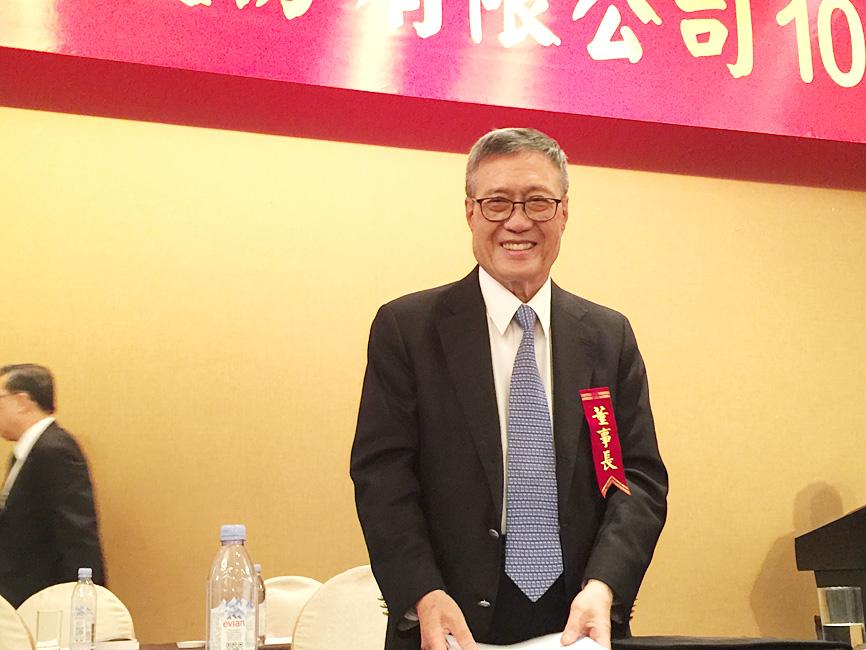Nanya Technology Corp (南亞科技) expects a further uptick in DRAM chip prices during the second half of this year, extending a three-quarters-long price uptrend, as the world’s major memorychip suppliers are being disciplined about capacity expansion.
“Based on information from the world’s top three suppliers, they have been conservative about capital spending over the past two years. The growth in [DRAM] supply this year mainly derives from technology upgrades, meaning the output increase will be very disciplined,” Nanya Technology chairman Wu Chia-chau (吳嘉昭) said yesterday during opening remarks at the company’s annual shareholders’ meeting in Taoyuan’s Nankan District (南崁).
“Overall, supply and demand should reach a balance this year based on the analysis of some research houses,” Wu said.

Photo: Chang Hui-wen, Taipei Times
Compared with stable supply growth, DRAM demand is rising rapidly as work-from-home, online learning and the stay-at-home economy boost demand for notebook computers, tablets, solid state drives and networking devices, he said.
In addition, DRAM demand is being propelled by 5G infrastructure, 5G handsets, artificial intelligence and other emerging technologies, as those devices are equipped with much bigger memory, he added.
As a result, Nanya Technology expects the DRAM industry is moving toward healthy development in the third and fourth quarters of this year.
“It looks more certain that DRAM market prices will have some upside,” Wu said.
Nanya Technology last month said that it was not sure whether the price increases would be sustained in the final quarter of this year.
There was a likelihood prices might be flat compared with this quarter, it said.
The global DRAM market grows at an annual rate of 15 to 20 percent on average each year and most suppliers target matching that pace in their capacity expansion, Nanya Technology said.
To fuel growth, Nanya Technology is developing 10-nanometer technologies, with its second-generation 10-nanometer chips scheduled to start small-volume production soon, Wu said.
The company also plans to start building a new 12-inch fab in New Taipei City’s Taishan District (泰山) at the end of this year at the earliest, he said, adding that construction would likely be completed by the end of 2023.
The company plans to invest NT$300 billion (US$10.78 billion) to make 10-nanometer chips over the next few years.
At its existing fabs, Nanya Technology is optimizing its 20-nanometer product lineups to address rising demand for chips for servers, PCs, portable devices and automotive applications, Wu said.
Shareholders yesterday approved a proposal to distribute a cash dividend of NT$1.3 per common share.
That represents a payout ratio of 52 percent based on the company’s earnings per share of NT$2.5 last year, or NT$7.67 billion net profit.

China’s Huawei Technologies Co (華為) plans to start mass-producing its most advanced artificial intelligence (AI) chip in the first quarter of next year, even as it struggles to make enough chips due to US restrictions, two people familiar with the matter said. The telecoms conglomerate has sent samples of the Ascend 910C — its newest chip, meant to rival those made by US chipmaker Nvidia Corp — to some technology firms and started taking orders, the sources told Reuters. The 910C is being made by top Chinese contract chipmaker Semiconductor Manufacturing International Corp (SMIC, 中芯) on its N+2 process, but a lack

TECH BOOST: New TSMC wafer fabs in Arizona are to dramatically improve US advanced chip production, a report by market research firm TrendForce said With Taiwan Semiconductor Manufacturing Co (TSMC, 台積電) pouring large funds into Arizona, the US is expected to see an improvement in its status to become the second-largest maker of advanced semiconductors in 2027, Taipei-based market researcher TrendForce Corp (集邦科技) said in a report last week. TrendForce estimates the US would account for a 21 percent share in the global advanced integrated circuit (IC) production market by 2027, sharply up from the current 9 percent, as TSMC is investing US$65 billion to build three wafer fabs in Arizona, the report said. TrendForce defined the advanced chipmaking processes as the 7-nanometer process or more

NVIDIA PLATFORM: Hon Hai’s Mexican facility is to begin production early next year and a Taiwan site is to enter production next month, Nvidia wrote on its blog Hon Hai Precision Industry Co (鴻海精密), the world’s biggest electronics manufacturer, yesterday said it is expanding production capacity of artificial intelligence (AI) servers based on Nvidia Corp’s Blackwell chips in Taiwan, the US and Mexico to cope with rising demand. Hon Hai’s new AI-enabled factories are to use Nvidia’s Omnivores platform to create 3D digital twins to plan and simulate automated production lines at a factory in Hsinchu, the company said in a statement. Nvidia’s Omnivores platform is for developing industrial AI simulation applications and helps bring facilities online faster. Hon Hai’s Mexican facility is to begin production early next year and the

Who would not want a social media audience that grows without new content? During the three years she paused production of her short do-it-yourself (DIY) farmer’s lifestyle videos, Chinese vlogger Li Ziqi (李子柒), 34, has seen her YouTube subscribers increase to 20.2 million from about 14 million. While YouTube is banned in China, her fan base there — although not the size of YouTube’s MrBeast, who has 330 million subscribers — is close to 100 million across the country’s social media platforms Douyin (抖音), Sina Weibo (新浪微博) and Xiaohongshu (小紅書). When Li finally released new videos last week — ending what has